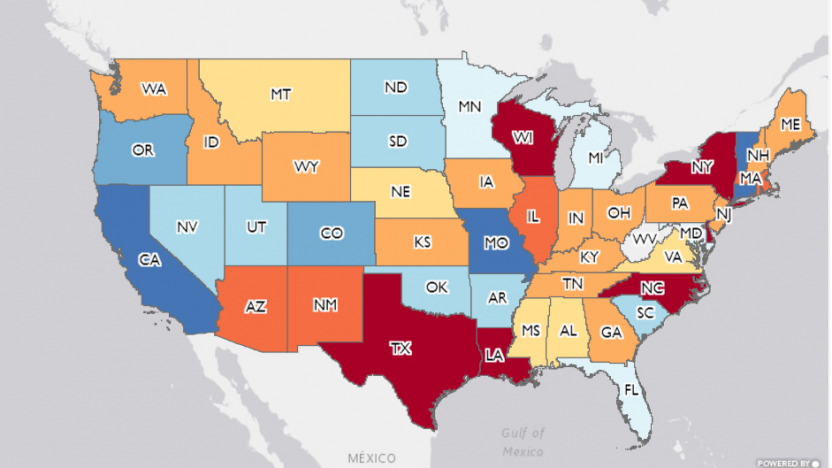
Louisiana Ranks Among Worst in U.S. for Cutting its State Environmental Agency in new EIP report
(Washington, DC)
During a decade of cuts at EPA fueled by rhetoric that environmental responsibility should be shifted from the federal to state level, 30 states cut funding for their own environmental agencies and 40 reduced their staffing, according to a new study of state budget records.
Louisiana had among the worst records in the U.S., slashing the funding for pollution control programs at the state Department of Environmental Quality by 35 percent from fiscal 2008 to 2018, when adjusted for inflation, and staffing at the agency by 30 percent, according to the Environmental Integrity Project report, “The Thin Green Line: Cuts to State Pollution Control Agencies”.
Only two states cut the funding at their environmental agencies as much or more over this time period, Wisconsin (36 percent) and Texas (35 percent), state records indicate.
“The Trump Administration has been trying to roll back EPA’s authority and funding by arguing that the states will pick up the slack and keep our air and waters clean,” said Eric Schaeffer, Executive Director of the Environmental Integrity Project (EIP).
“This is just a shell game, however,” said Schaeffer, former Director of Civil Enforcement at EPA, “because state agencies are often badly understaffed and the EPA workforce is already at its lowest level in more than thirty years.”
The cuts at LDEQ came during a decade of rapid expansion of the state’s chemical industry and increased damage to the Bayou State from climate change and coastal flooding.
“The Louisiana Department of Environmental Quality needs two things: more money in its budget and the will to enforce the law,” said Anne Rolfes, Director of the Louisiana Bucket Brigade, an environmental organization. “Demoralized employees lack the proper funding to do their jobs, and they are vulnerable to industry pressure to hurry permit approvals and cut corners.”
Funding for the LDEQ’s pollution control programs plummeted from $192 million in 2008 to $125 million in 2018, when adjusted for inflation. Over same period, the overall state budget for Louisiana shrank by much less, only 15 percent. LDEQ eliminated 296 full-time equivalent positions, with staffing declining from 994 full-time-equivalent positions in fiscal 2008 to 698 in 2018.
This lack of environmental prioritization should not be surprising: A 2011 EPA Inspector General report found Louisiana’s enforcement of environmental laws to be among the worst in the country.
The cost of environmental degradation is more tangible in Louisiana than in almost any other state. Driven by oil and gas industry development and rising sea levels, more than 2,000 miles of the state’s southern edge have literally washed away into the Gulf of Mexico, with a football disappearing about every 100 minutes.
Below are some of the major environmental challenges facing Louisiana that require a robust environmental protection agency, according to the Environmental Integrity Project’s report:
- More than a third of the petrochemical plants in the state (15 of 43) have been in continuous noncompliance with pollution control laws over the last three years, including the Phillips 66 Lake Charles refinery, the ExxonMobil Baton Rouge chemical plant, and Dow Chemical Co.’s Louisiana Operations, according to EPA records.
- Louisiana has approved hundreds of air pollution control permits for industry sites since 2012, including 41 for major oil and gas processing projects, with another 11 companies currently seeking approval for construction or expansion.
- Louisiana has 7,388 oil and gas drilling facilities, and accounts for seven percent of U.S. gas production. The state is the ninth largest crude oil producer and fourth largest natural gas producer in the U.S.
- Louisiana currently has 12 major wastewater plants and industrial facilities in significant noncompliance with the federal Clean Water Act, including two—the Baton Rouge and Springhill sewage treatment plants—in continuous violation for the last three years, according to EPA records.
- The state also has 72 industrial facilities with what EPA considers “high priority” violations of the Clean Air Act, and 49 with current violations of hazardous waste laws, EPA records show.
Nationally, according to the Environmental Integrity Project report, the White House and Congress reduced EPA’s funding and staffing for pollution control and science programs by 16 percent from 2008 to 2018, when adjusted for inflation.
During this period, many states slashed their own environmental agency funding by an even greater percentage– including Louisiana, with its 35 percent funding cut to the LDEQ, and 30 percent staffing cut.
Across the U.S., the steep reductions at state environmental agencies and EPA came despite evidence that many environmental violations are resulting in no enforcement or penalties.
For example, EPA records show there are 2,098 sewage plants, factories, and other industrial sites in the 50 states that are currently in significant violation of federal air, water, or hazardous waste pollution control laws, including 1,255 that have been in violation every quarter continuously for the last three years. Of these 1,255 sites with chronic violations, 80 percent (1,008) are in states with environmental agencies that have suffered staffing cuts, according to the EIP report.
The Environmental Integrity Project examination of state budget records from 2008 to 2018 found:
- Thirty states reduced the funding for their environmental agencies’ pollution control programs. Twenty-five states imposed cuts of at least 10 percent on their environmental agencies. Sixteen states reduced spending by more than 20 percent, when adjusted for inflation.
- Although coastal flooding driven by a changing climate is on the increase, seven of the 10 states with the sharpest cuts to their environmental agencies are coastal states that are disproportionately hurt by rising sea levels, including Louisiana, North Carolina, and New York.
- Forty states reduced the staffing levels at their environmental agencies over this decade. Twenty-one states cut their environmental workforce by at least 10 percent, and nine by 20 percent or more.
- Overall, states eliminated more than 4,400 positions at agencies responsible for protecting the environment.
Policy Recommendations Outlined in the Report:
- Industry lobbyists and politicians should stop pretending that shifting more responsibility for environmental programs from federal to state agencies won’t tear big holes in the safety net that protects public health. This is a fallacy when most state environmental agencies have been weakened by budget and workforce cuts.
- Governors and lawmakers in Texas and other states should fund state environmental agencies sufficiently to allow them to hire enough inspectors, permit writers, scientists, engineers, and other professionals to implement federal laws that protect public health, clean air, and clean water. That should be done by increasing permitting fees for industry that most states already collect.
- Congress could help with more funding for both EPA and state agencies. But any increases for the states should not be taken out of EPA operating programs, because EPA’s workforce has already shrunken to levels not seen since the Reagan Administration.
For an online data map with budget and staffing data for all 48 lower U.S. states, click here.
The Environmental Integrity Project is a nonprofit, nonpartisan organization based in Washington, D.C., and Austin, Texas, that protects public health and the environment by investigating polluters, holding them accountable under the law, and strengthening public policy.
###
More reading:
- Full EIP report (PDF)
- NOLA.com/The Advocate: “Louisiana’s DEQ saw among largest cuts to state environmental agencies over past 10 years”
- Reuters: “Most U.S. states have cut environmental budgets and staffing since 2008: study”
- The Hill: “States slashed 4,400 environmental agency jobs in past decade: study”
CONTACT:
Tom Pelton, Environmental Integrity Project (443) 510-2574 or tpelton@environmentalintegrity.org
Anne Rolfes, Louisiana Bucket Brigade (504) 452-4909 or anne@labucketbrigade.org
